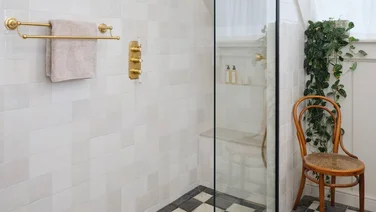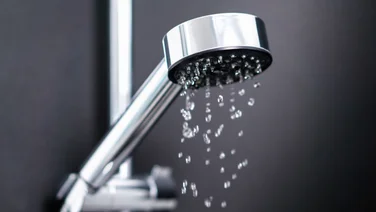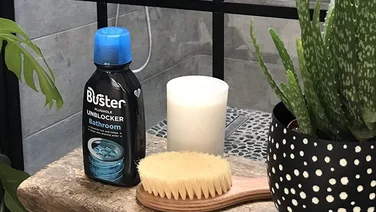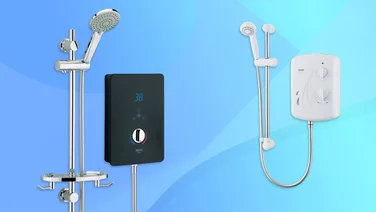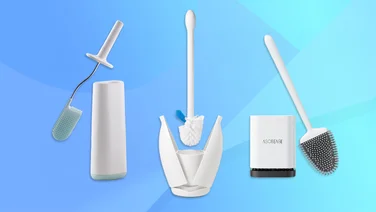To help us provide you with free impartial advice, we may earn a commission if you buy through links on our site. Learn more
- 1. Dip the shower head in vinegar
- 2. Soak it in lemon juice
- 3. Deal with limescale using denture tablets
- 4. Sit your shower head in a baking powder solution
- 5. Try a specialist supermarket cleaner
- 6. Swill it in citric acid
- How can I protect my shower head from limescale build up?
- What should you never use to clean a shower head?

Although not an uncommon problem, limescale on a shower head is something you’ll want to deal with, pronto. Not only will it look pretty unsightly, but it will also affect the flow of water, ruining your entire showering experience.
“Limescale, or calcium carbonate, leaves watermarks and chalky white deposits in your shower after any standing water evaporates,” explains Kerry Hale, bathroom expert at Mira Showers. “If you live in an area with hard water, you’re more likely to find limescale build-up in your bathroom or kitchen appliances.”
The great news is that it is quite possible to remove limescale from your shower, often using household products you’re already likely to have in your cupboards. Here, we bring you the best methods to try – as well as giving you some tips on preventing the problem from returning.
1. Dip the shower head in vinegar
It might come as no surprise to find vinegar top of the list – is there anything this household staple (and fish ’n’ chip must-have) can’t do? Alex Woods, bathroom expert at Victorian Plumbing, shares her preferred DIY hack using white vinegar to clean your shower head.
“Vinegar is a great option for removing limescale, as the chalky build-up reacts with the acidity of vinegar helping to break it down,” she explains. “The trick with this hack is to fill a ziplock bag with white vinegar and insert the shower head, tying it with an elastic band to keep it in place. The head needs to sit in the solution for between 15 minutes to half an hour, allowing all the limescale to dissolve. Just be sure to rinse the showerhead before use after sitting in the vinegar!”
Alex isn’t the only expert we spoke to that extols the magic of vinegar. “Before you buy expensive descaling products, try white vinegar,” agrees Kerry Hale. “Vinegar is the number one natural cleaning product, making it an effective and affordable shower head cleaner. However, malt vinegar isn’t particularly effective and brown vinegar may stain, so white distilled vinegar is best.”
It is worth noting here that some finishes could be adversely affected by vinegar. “Be cautious when cleaning other metals such as brass with vinegar and avoid using it on black shower heads,” advises Alex Woods.
2. Soak it in lemon juice
Next up, another well-known natural cleaning product – lemon juice. Not only is it great for cleaning all kinds of household grime, it also smells good. “One of the best ways to get rid of stubborn limescale deposits is by soaking the affected area in lemon juice,” says Kerry Hale, although she has a little warning about using these natural solutions.
“Although these natural cleaning products might seem harmless, they can cause skin irritation, and lemon can act as a bleaching agent when exposed to sunlight. Be sure to wear gloves throughout the whole process and protect your clothing.”
If you decide to give this method a try, soak a cleaning rag in lemon juice before wrapping it around your shower head, securing it in place with a rubber band. After an hour or so, unwrap the rag and scrub the remaining limescale away.
3. Deal with limescale using denture tablets
Here’s one option you might not have considered – denture tablets. If you don’t have these hanging around at home, don’t worry as they’re affordable to buy.
“I have been cleaning luxury London bathrooms for years and tested countless products on severely calcified shower heads,” reveals Evie Graham, founder of WasteDirect. “I’ve found that denture tablets contain the perfect combination of citric acid and mild abrasives. Just remove your shower head, place it in a plastic bag with two dissolved tablets and let it sit overnight. I’ve found that this simple method is 80% more effective than dedicated limescale products costing five times more.
4. Sit your shower head in a baking powder solution
Both baking soda (otherwise know as bicarbonate of soda) and baking powder can be used to remove a build-up of limescale.
“One of the oldest household remedies to remove limescale from a shower head can be found in (almost) every kitchen cupboard: baking powder, which is normally used to make sponge cakes and pastries light and airy,” explains Yiota Toumba, senior designer at Villeroy & Boch. “The sodium bicarbonate in baking powder dissolves the limescale, ensuring a clean, hygienic and perfectly functioning shower head.”
While bicarbonate of soda (also known as baking soda) tends to be a little more effective, both can be used for the task. Simply dissolve it in water and leave the shower head to sit in the solution overnight before wiping and rinsing away any remaining residue.

5. Try a specialist supermarket cleaner
Sometimes, however keen you are to take an all-natural approach to cleaning, only specialist cleaners seem to do the trick. Our recommended best shower cleaners, for example, are all up to the task.
“Although vinegar can be a highly effective way to clean your shower head, stubborn limescale might require something more potent,” explains Kerry Hale. “If you’ve tried this method and are still unsure how to remove limescale from shower heads with a large build-up, specialist limescale cleaners are relatively easy to find in supermarkets. That said, always take care when using these products. Wear gloves and don’t spray products overhead in case you get chemicals in your eyes.”
6. Swill it in citric acid
Although anything containing the word ‘acid’ can sound a bit scary, there are actually lots of uses for citric acid around the home, including in many recipes and you can pick up something like this 1KG Bucket of Citric Acid from Amazon for under £10.
“Cleaning with baking powder or vinegar is very gentle on the material, but is rather time-consuming,” explains Yiota Toumba. “A quicker way is to use citric acid, which you can buy as a powder from any hardware shop although please always follow the dosage and safety instructions on the packaging when using it.”
If you take this route, be sure to wear gloves. “Dissolve a level teaspoon of citric acid in a little cold water and add the mixture to a bowl,” says Yiota Toumba. “Swirl the shower head back and forth so that the acid can reach every part of it. Allowing it to sit for 15 to 45 minutes will effectively descale the showerhead.”

How can I protect my shower head from limescale build up?
If you want to stop limescale building up on your shower head in the first place, our go-to is glycerin.
“Glycerine creates an invisible protective barrier, preventing limescale formation entirely,” explains Evie Graham. “After deep cleaning, just wipe pure glycerin across all metal surfaces. One application typically lasts two to three months which dramatically reduces maintenance needs.”
What should you never use to clean a shower head?
Despite its many uses around the home, there is one household cleaning product you should definitely avoid using to clean your shower head — bleach.
Not only can bleach cause damage to chrome, brass, nickel and even those on-trend matt, coloured finishes, such as black, it also has some other worrying effects. If any bleach residue remains, it could cause skin irritation. Also, if you have already tried vinegar and then add bleach to the mix, it can form harmful chlorine gas that’s poisonous if inhaled.




